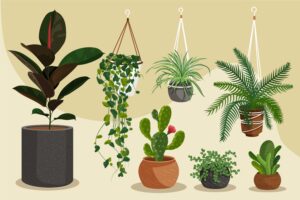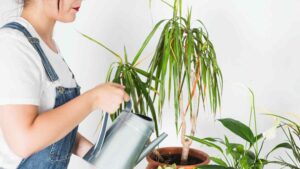Table of Contents
| Common Name | Dracaena; various species have different common names |
| Botanical Name | Dracaena spp. |
| Family | Asparagaceae |
| Plant Type | Shrub |
| Mature Size | 2-10 ft. tall, 1-2 ft. wide |
| Sun Exposure | Partial |
| Soil Type | Moist, well-drained |
| Soil pH | Acidic |
| Hardiness Zones | 10–12 (USDA) |
| Native Area | Asia, Africa, Australia |
| Toxicity |
Dracaena plants are available in multiple sizes and shapes, but all share a main characteristic–their long leaves grow outward and up from a central stalk or cane. Interestingly, the canes are sturdy, lending an unexpected architectural element to the whimsical foliage.
Dracaena plants are ideal for bare walls, spaces behind furniture, or tight spaces because of their upright growth.
When discussing the benefits and how to care for a Dracaena plant, they are superior in this way. Growing them is easier, has affordable prices, and is considered best for indoor placement with partial sunlight.
Interestingly, there is research that says these plants are detoxifying agents. They can purify air and remove toxins from their surroundings.
Most species are native to Africa, southern Asia, and northern Australia, with two species in tropical Central America.
Interestingly, species have a secondary thickening meristem in their trunk, termed Dracaenoid thickening by some authors, which is quite different from the thickening meristem found in dicotyledonous. When we talk about the properties they are shared with members of the Agavoideae and Xanthorrhoeoideae among other members of the Asparagales.
Types of Dracaena Plants

The species of Dracaena plants are divided into two growth groups: Firstly, there are treelike (fragrans, draco, cinnabari), which have aboveground stems that branch from points after flowering, or if the growth tip is severed. The second category consists of rhizomatous dracaenas (trifasciata, angolensis), which feature surface-level leaves that can be strap-like or cylindrical and subterranean rhizomes.
-
- The corn plant (Dracaena fragrans)
-
- Dragon tree (Dracaena marginata)
-
- Lucky bamboo (Dracaena sanderiana)
-
- Florida Beauty
-
- Song of India (Dracaena reflexa)
Moreover, many species are kept indoors due to tolerance of lower light and sparse watering.
There are 120 species of trees and succulent shrubs of Dracaena Plants. This includes the previously recognized genera Pleomele and Sansevieria. The system of APG IV classification system is placed in the family Asparagaceae, subfamily Nolinoideae (formerly the family Ruscaceae). Initially, it was divided into the family Dracaenaceae or sometimes placed in the group of Agavaceae.
How to Care for Dracaena Plant

Here are the main care requirements for growing: Here we are going to elaborate, on how to take care of a dracaena plant.
-
- Firstly, choose a location in bright, indirect light or dappled sun outdoors.
-
- Must grow it in a well-draining, slightly acidic potting mix or garden soil.
-
- Watering regularly in spring and summer and reduce watering in winter.
-
- You should maintain the humidity in the environment for the house.
-
- Providing fertilizers once in a while is recommended for optimum results.
-
- During spring or summer, prune to control excessive growth.
Appropriate Planting Method
The planting method is the most important factor, USDA Zones 10-11, you can grow dracaena plants in the landscape. In this way, there is much larger growth than a house so make sure the species of your choice fits the location as it grows into a mature one, often a sizeable tree.
Choose a spot that receives some shade—ideally, shade from other plants that casts dappled shadows. Direct sunlight is not better, if it receives direct sun, the morning sun is preferable to the hot and unbearable afternoon sun. Moreover, there is also the importance of soil, location needs to be well-draining and slightly acidic, with a pH between 6.0 and 6.5.
Light
The placement of dracaena plants is important, the better is to place them in an area that gets indirect light. It bears short periods of direct sunlight, long exposures will cause leaf scorch. When it comes to indoor areas, it also tolerates low-light conditions although it will grow better with more exposure to indirect light. Outdoors, it need a location in partial shade or dappled sun.
Soil
For potted, use any peat-based commercial potting mix, which has the slight acidity that these plants prefer.
Additionally, we must know how to care for a Dracaena plant is mostly grown in if they are grown in landscapes in tropical regions, the soil should be rich and well-drained.
Water
Here we are discussing how to care for a dracaena plant regarding water. Maintaining the water level is so essential for their life. They are succulents so they store water in them for survival days. We should provide them with clean water. The fluoride water is not good. They need more water in summer and spring as compared to fall and winter.
Temperature and Humidity
The factors of temperature and humidity impact plants effectively. In this way, every gardener should be careful about it. When talking about succulent dracaena, there are most of the species survive at 70 to 80 Fahrenheit. They cannot survive below or greater than the mentioned range of temperature.
These plants are tropical and they are used to highly humid surroundings. In this way, there is an issue in the dry winters regarding maintaining appropriate humidity levels. Therefore, there are some artificial methods those are mist and room humidifiers to maintain the appropriate level of humidity.
Fertilizer
In this era, there are a lot of challenges to the plants. We have destroyed our air quality through vehicles, factories, electric appliances, nuclear weapons, and environmental pollution. So there are solutions for sustaining the life of plants through fertilizers. You can use a fertilizer for Dracaena plants once a month. Using fertilizer in the month of fall and winter is not recommended at all.
This is not compulsory to give fertilizer, but if you provide them with fertilizers once a once it is beneficial for their growth. In this way the better duration is spring and summer, giving the house a monthly feeding with a water-soluble fertilizer formulated for the house. Do not provide fertilizers in the winter and fall seasons, this is not recommended.
Challenges with Dracaena Plants
To look after this is important, so we are going to discuss how to care for a dracaena plant. Here we will discuss the main challenges faced by them, which often manifest themselves through the leaves.
Browning Leaves
The browning of leaves is caused by fluorides because Dracaena plants are sensitive to them, and built-up up salts, which can cause leaves to turn brown. If there is browning of leaves so immediately use non-fluoridated water, with an especially deep watering once monthly to flush out salts. Moreover, can also occur if indoor humidity levels are too low; mist the plant regularly or use a room humidifier to rectify this.
Scorched Leaves
Excessive sunlight can scorch the leaves. You should move it to a spot where is it less exposed to direct sunlight. If the only available location is a windowsill, use a sheer curtain to filter the light.
Wilted Leaves
The issue of wilting leaves is so common. You must have seen the wilting process in most of the plants. There are several reasons for this problem. Regarding how to care for a Dracaena plant, there is the worst sign of dehydration. So you should provide the appropriate amount of water. So that you can overcome this issue.
Conclusion
The Dracaena plant is one of the most likable plants for people, they love to grow it in their gardens because of its captivating looks. Moreover, they are considered air-purifying plants. They work as detoxifying agents.
How to care for a dracaena plant? This is the most common question that people ask. There are some basic and some specific rules and regulations to take care of this plant.
You can use fertilizers once a month to boost growth and make it sustainable in harsh conditions.
The reason for wilting or yellowing is sunlight and watering. These both are the main reasons that lead to the issue. So must care about the appropriate watering and sunlight exposure to these succulents.
FAQs
How do you define the term Dracaena plants?
Interestingly, these plants have 120 species of trees and succulent shrubs.
Is there a need for Fertilizers for Dracaena plants?
Not at all, but there may be the importance of fertilizers in specific conditions.
Is it possible to place Dracaena Plants Indoor?
They can survive in low or indirect sunlight. In this way, they can be placed in indoor areas.
Is there any solution for the Yellowing?
You ought to cut off the excessive source of watering.
Read More About: succulent varieties
